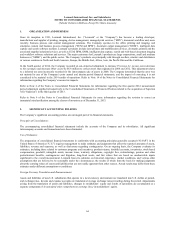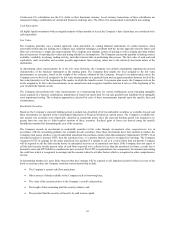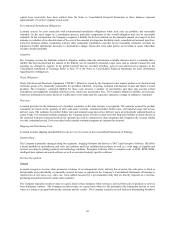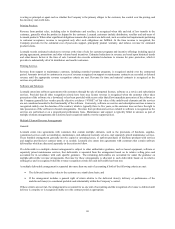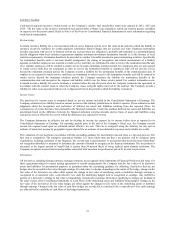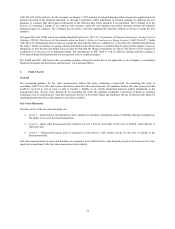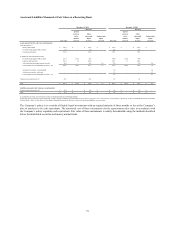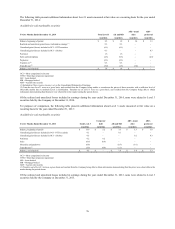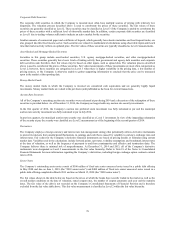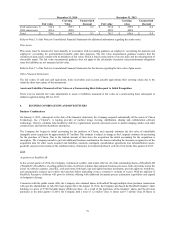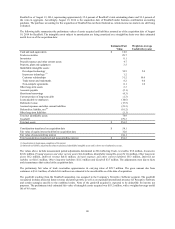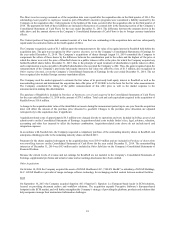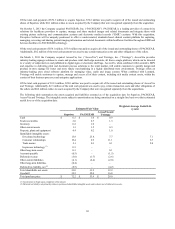Lexmark 2014 Annual Report Download - page 77
Download and view the complete annual report
Please find page 77 of the 2014 Lexmark annual report below. You can navigate through the pages in the report by either clicking on the pages listed below, or by using the keyword search tool below to find specific information within the annual report.
Net Earnings Per Share:
Basic net earnings per share is calculated by dividing net income by the weighted average number of shares outstanding during the
reported period. The calculation of diluted net earnings per share is similar to basic, except that the weighted average number of shares
outstanding includes the additional dilution from potential common stock such as stock options, restricted stock units, and dividend
equivalents.
Accumulated Other Comprehensive (Loss) Earnings:
Accumulated other comprehensive (loss) earnings refers to revenues, expenses, gains and losses that under U.S. GAAP are included in
comprehensive (loss) earnings but are excluded from net income as these amounts are recorded directly as an adjustment to
stockholders’ equity, net of tax. Lexmark’s Accumulated other comprehensive (loss) earnings is composed of unrealized gains on cash
flow hedges, unamortized prior service cost or credit related to pension or other postretirement benefits, foreign currency translation
adjustments and net unrealized gains and losses on marketable securities including the non-credit loss component of OTTI. The
Company presents each item of other comprehensive (loss) earnings, on a net basis, and related tax amounts in the Consolidated
Statements of Comprehensive Earnings, displaying the combination of reclassification adjustments and other changes as a single
amount. Reclassification adjustments, including related tax amounts, are disclosed in Note 15 of the Notes to Consolidated Financial
Statements. For any item required under U.S. GAAP to be reclassified to net income in its entirety in the same reporting period, the
affected line item(s) on the Consolidated Statements of Earnings are provided. For other amounts not required to be reclassified to net
income in their entirety, such as pension-related amounts, the Company provides in Note 15 a cross-reference to related footnote
disclosures.
Recent Accounting Pronouncements:
Accounting Standards Updates Recently Issued and Effective
In July 2013, the Financial Accounting Standards Board (“FASB”) issued Accounting Standards Update No. 2013-11, Income Taxes
(Topic 740): Presentation of an Unrecognized Tax Benefit When a Net Operating Loss Carryforward, a Similar Tax Loss, or a Tax
Credit Carryforward Exists (“ASU 2013-11”). ASU 2013-11 requires that unrecognized tax benefits be presented as a reduction to
deferred tax assets for all same jurisdiction loss or other tax carryforwards that are available and would be used by the entity to settle
additional income taxes resulting from disallowance of the uncertain tax position. The amendments in ASU 2013-11 became effective
for the Company’s fiscal year beginning January 1, 2014 and were applied prospectively, which resulted in a reduction of
approximately $1 million to Other assets and Other liabilities upon adoption. The amendments in ASU 2013-11 did not have a
material effect on the Company’s Consolidated Statement of Financial Position as of December 31, 2014.
Accounting Standards Updates Recently Issued But Not Yet Effective
In April 2014, the FASB issued Accounting Standards Update No. 2014-08, Presentation of Financial Statements (Topic 205) and
Property, Plant, and Equipment (Topic 360): Reporting Discontinued Operations and Disclosures of Disposals of Components of an
Entity (“ASU 2014-08”). Under ASU 2014-08, only a disposal of a component or a group of components that represents a strategic
shift that has (or will have) a major effect on an entity’s operations and financial results will qualify as a discontinued operation. In
addition, under the revised definition, reporting discontinued operations will no longer be precluded when the operations and cash
flows of the disposed component have not been eliminated from ongoing operations or when there is significant continuing
involvement with the component after disposal. The amendments in ASU 2014-08 will be effective prospectively for the Company in
the first quarter of 2015. The Company does not anticipate a material impact to its financial statements from ASU 2014-08, absent any
disposals of components or groups of components that represent a strategic shift having a major effect on the Company’s operations
and financial results in future periods.
In May 2014, the FASB issued ASU No. 2014-09, Revenue from Contracts with Customers (Topic 606) (“ASU 2014-09”). ASU
2014-09 is a new comprehensive standard for revenue recognition that is based on the core principle that revenue be recognized in a
manner that depicts the transfer of goods or services to customers in an amount that reflects the consideration to which the entity
expects to be entitled in exchange for those goods or services. Under the new standard, a good or service is transferred to the customer
when (or as) the customer obtains control of the good or service, which differs from the risk and rewards approach under current
guidance. The new standard provides guidance for transactions that were not previously addressed comprehensively, including service
revenue and contract modifications, eliminates industry-specific revenue recognition guidance, including that for software, and
requires enhanced disclosures about revenue. ASU 2014-09 affects any entity that enters into contracts with customers to transfer
goods or services, except for certain contracts within the scope of other standards (such as leases), and is also applicable to transfers of
nonfinancial assets outside of the entity’s ordinary activities. Areas of potential change for the Company include, but are not limited
to, units of accounting, the determination of the transaction price, the allocation of the transaction price to multiple goods and services,
transfer of control, software licenses, and capitalization of contract costs.
73



